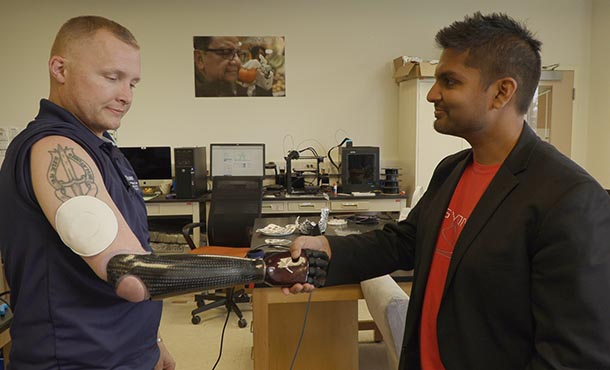
Retired U.S. Army Sgt. Garrett Anderson shakes a hand while wearing Northwestern's epidermal VR patch on his upper arm. The patch is integrated with his prosthetic arm to give more sensory feedback when holding an object. IMAGE: NORTHWESTERN UNIVERSITY
Engineering professor contributed to 'epidermal virtual reality' paper in Nature
12/12/2019
By Ashley WennersHerron
EVANSTON, Il. — Xin Ning, an assistant professor of aerospace engineering at Penn State, contributed to a study published in November in Nature. He completed the work during his time as a postdoctoral scholar in the laboratory of John Rogers, professor of mechanical engineering at Northwestern University.
The Northwestern University team, including Ning, developed a new thin, wireless system that adds a sense of touch to any virtual reality (VR) experience. Not only does this platform potentially add new dimensions to our long-distance relationships and entertainment, the technology also provides prosthetics with sensory feedback and imparts telemedicine with a human touch.
Referred to as an “epidermal VR” system, the device communicates touch through a fast, programmable array of miniature vibrating actuators embedded into a thin, soft, flexible material. The 15-centimeter-by-15-centimeter sheet-like prototypes comfortably laminate onto the curved surfaces of the skin without bulky batteries and cumbersome wires.
Ning is now applying what he learned on this project to his current work at Penn State.
“I’m taking this kind of thin, flexible electronic system and working to apply it to large structures that can be deployed in space,” Ning said. “I’m specifically interested in developing foldable electronics that can be easily transported off of Earth and utilized in the construction of satellites and other assemblies that are bulky and difficult to move.”
Read the full, original press release issued by Northwestern University here.



